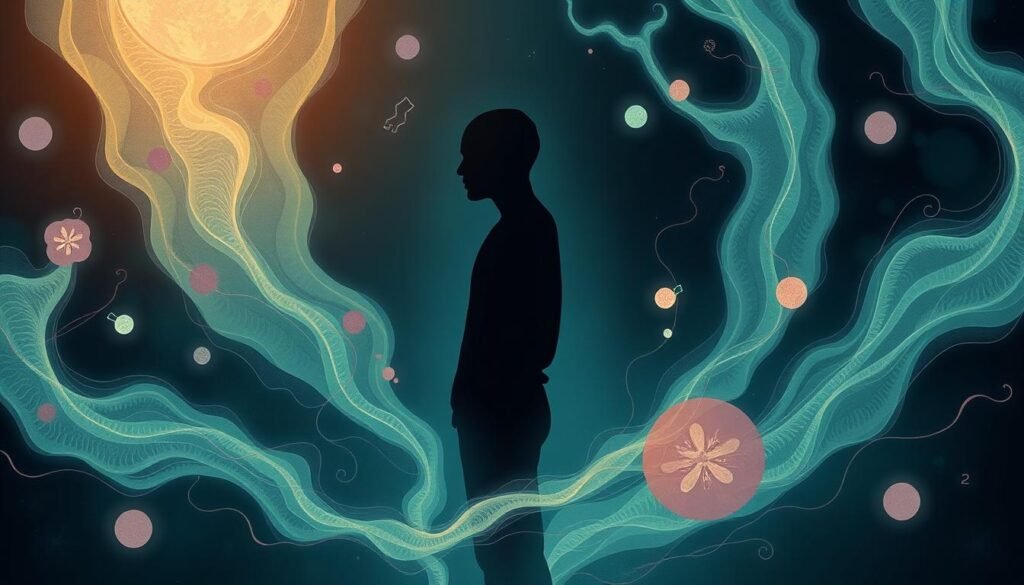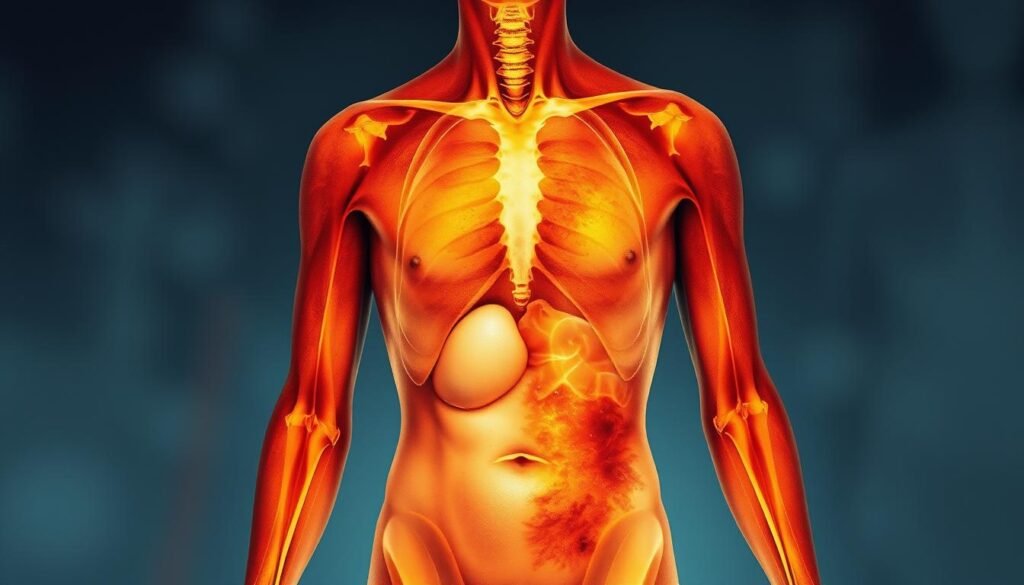Over 70% of cancer patients receive radiation therapy during their treatment. This method is great at attacking cancer cells. But, it can also harm healthy tissues nearby. The side effects of radiation are more than just small setbacks; they can deeply affect a patient’s life. So, it’s key for patients and caregivers to know about these effects and how to handle them.
Radiation therapy is a key weapon against cancer, shrinking tumors and destroying cancerous cells. Yet, it doesn’t only hit harmful cells; it also affects good cells. This can lead to physical and emotional challenges. By knowing the different radiation therapy side effects, patients can deal with these issues better. This knowledge helps make treatment and recovery smoother.
Key Takeaways
- Fatigue is the most common issue from radiation therapy, hitting many after two weeks of treatment.
- Skin changes, like redness and blistering, are common too and are called radiation dermatitis.
- Hair loss at the treatment site can happen, especially when the head is targeted.
- The side effects can vary a lot depending on the treated area, with abdominal radiation often leading to gastrointestinal problems.
- Most side effects start to get better weeks after treatment ends, but some may last longer or appear later.
- Dealing with these effects usually needs rest, taking care of your skin properly, and eating right to stay healthy during treatment.
- It’s important to have a care plan after treatment to watch for long-term effects and health risks post-radiation therapy.
Introduction to Radiation Therapy
Radiation therapy is key in treating cancer, used commonly as a primary method for many. It employs high-energy waves, like X-rays, aiming at cancer cells while sparing healthy ones. Over half of cancer patients will undergo radiation therapy at some stage.
Radiation therapy is not one-size-fits-all. It’s customized based on cancer type, its location, and the treatment plan. This approach helps manage side effects, which can include hair loss, skin issues, and fatigue. However, these effects differ from person to person.
Radiation may work alone or alongside surgery and chemotherapy. There are three main ways to administer it: external beam, internal, and systemic radiation therapy. Each method and technique, such as 3D conformal radiation or intensity modulated radiation therapy, meets specific treatment needs.
While radiation helps many, it can have late side effects. These underscore the need for ongoing talks with healthcare providers. It’s crucial for patients to share concerns during or after therapy. Regular check-ups and imaging tests after treatment are key to comprehensive care.
What is Radiation Therapy?
Radiation therapy is key in fighting cancer cells. It uses high-energy beams to target tumors. This destroys or slows their growth. Radiation therapy is often given in two ways: external beam radiation and brachytherapy. The latter places radioactive materials close to or inside the tumor.
Research has shown the benefits of this treatment. However, it’s important to know about the side effects. These side effects vary from person to person and depend on the treatment.
| Type of Side Effect | Description |
|---|---|
| Early Side Effects | Include symptoms like nausea, fatigue, and skin irritation, typically appearing during or shortly after treatment. |
| Late Side Effects | Manifest months or even years later, potentially leading to complications such as lung or heart problems, or an increased risk of a second cancer. |
| Common Early Symptoms | Fatigue and skin problems often arise, which can vary depending on the treatment area. |
| Potential Complications | May include digestive issues when targeting abdominal areas and fertility concerns with pelvic radiation. |
Knowing about radiation therapy helps people get ready for treatment. It also helps in understanding the side effects. This knowledge supports patients throughout their healing journey.
Common Side Effects of Radiation Therapy
Radiation therapy is a key treatment for many types of cancer. But, it often leads to side effects like fatigue, skin changes, and hair loss. These effects mostly hit the area under treatment. Knowing about these side effects helps people understand what they might go through.
Fatigue and Exhaustion
Feeling very tired is a common side effect of radiation therapy. This tiredness might stay even after treatment ends. For some, this becomes a long-term problem, making everyday tasks hard. Yet, simple exercises, like daily 20-minute walks, can help beat this fatigue.
Skin Changes and Irritation
Skin irritation often shows up where the body gets radiation. This might look like redness, soreness, or dermatitis. Good skincare is key to lessen these issues. It can prevent infections and ease recovery. Patients should closely follow their healthcare team’s skin care advice.
Hair Loss
Hair loss can happen, mainly in areas like the head or chest treated with radiation. While it’s not common, some might lose hair in the underarm or on the chest. The good news is, hair usually grows back after therapy ends. This helps patients feel normal again.
Why Do Side Effects Occur?
Side effects from radiation therapy happen because the treatment affects the body deeply. Although it targets cancer cells, it can mistakenly harm healthy tissues too. This leads to symptoms during and after the therapy.
Impact on Healthy Cells
Radiation therapy’s goal is to kill cancer cells. But it can also damage nearby healthy cells. This damage causes side effects like tiredness, skin problems, and hair loss. Skin changes, for example, can alter how a person looks and feels.
Treatment precision and individual differences affect how much harm is done. This shows why careful health management is vital during therapy.
Factors That Influence Side Effects
A few key things affect the severity of side effects. These include:
- Treatment area: The part of the body getting radiation plays a big role in what side effects occur.
- Radiation dose: Higher doses can lead to more serious problems and damage to healthy cells.
- Individual health status: A person’s overall health, past medical issues, or genetic factors can change how they respond to radiation. This includes the impact of side effects.
- Combined therapies: Having extra treatments like chemotherapy can also influence how the body reacts to radiation.
For more details on radiation therapy’s effectiveness and how to manage it, check out this resource.

Side Effects of Radiation: Early vs. Late Effects
Knowing the difference between early and late radiation therapy effects is key for patients. Early effects usually show up soon after treatment starts. Late effects can appear months or years later. Both kinds of side effects can change how a patient feels and require different ways to deal with them.
Understanding Early Effects
Early side effects often start in the first few weeks of treatment. They are generally mild and manageable. Patients might experience:
- Fatigue and exhaustion
- Skin irritation or radiation dermatitis
- Hair loss in the targeted area
- Low blood counts
These early side effects tend to get better and may go away a few months after treatment ends. It’s comforting to know that these symptoms can be treated and usually improve quickly.
Identifying Late Effects
Late effects can come up well after the radiation treatment timeline. They depend on factors like the dose of radiation and the treated area. Possible late effects include:
- Memory loss or cognitive changes for brain radiation
- Changes in bowel habits and bladder function post pelvic radiotherapy
- Increased risk of secondary tumors over time
It’s important for patients to understand these late effects to manage their health over time. Keeping in touch with doctors and regular check-ups help with any new issues. For more info on managing side effects of radiation therapy, see this resource.
Specific Side Effects Based on Treatment Area

The side effects from radiation depend on where you receive treatment. Different areas of the body face different challenges. Knowing these side effects helps in dealing with them better.
Brain
Brain radiation can cause noticeable side effects. These include feeling tired, sick, and having trouble remembering things. Hair loss might occur about 2 to 3 weeks after starting treatment.
These effects should be closely watched. Supportive care is important to help manage them.
Head and Neck
Radiation in the head and neck can cause specific problems. Dry mouth and difficulty swallowing are common. Swallowing usually gets better after finishing treatment.
The inside of your mouth may hurt, making it hard to eat or drink. Getting the right help on time is important.
Chest and Breast
Radiation to the chest or breast can lead to skin changes and coughing. The skin might get dry and itchy but often gets better 2 to 4 weeks after treatment ends. Your breathing may also be affected but it usually improves.
Using the right skincare and getting support can make a big difference during recovery.
Abdomen and Pelvis
Radiation to the abdomen and pelvis often causes belly upset. You might feel sick or have diarrhea a few days after starting treatment. It can also make you feel anxious or stressed.
There could be issues with fertility or sexual health. It’s good to talk about these issues early and get support.
Managing Side Effects of Radiation
Learning to manage the side effects of radiation makes life better during treatment. This includes handling fatigue, taking care of your skin, and eating right. These steps are key for patients facing these issues.
Tips for Coping with Fatigue
Fatigue from radiation can last weeks after treatment ends. It’s crucial for patients to find ways to deal with it. Here’s how:
- Plan your day to match your energy levels.
- Do light exercises like yoga to lower stress and feel better overall.
- Focus on getting good sleep and use ways to relax, like deep breathing or meditation.
- Being part of a support group can ease stress and help you connect with others.
Skin Care Recommendations
Looking after your skin is important during radiation to reduce discomfort. Some helpful tips include:
- Shower with lukewarm water and use gentle soaps to not irritate your skin.
- Use a sunscreen of SPF 30 or more to keep your skin safe from the sun.
- Stay away from products with harsh chemicals that can bother your skin.
- Moisturize your skin to keep it from drying and itching.
Diet and Nutrition
Eating right during radiation can lessen stomach issues and make you feel better. Here’s what you can do:
- Have small meals often to deal with changes in how hungry you feel.
- Drink lots of water to help with nausea and keep your body working right.
- Don’t smoke to avoid making mouth sores worse.
- Choose foods that are easy on your stomach in case you feel sick or throw up.
| Nutrition Tips | Benefits |
|---|---|
| Smaller, frequent meals | Ease nausea and maintain energy levels |
| Hydration | Support overall health and reduce fatigue |
| Gentle exercise | Boost energy and improve mood |
| Proactive skin care | Mitigate irritation and enhance comfort |
By using these tips, patients can make their radiation treatment go more smoothly. This leads to better health and well-being overall.
Radiation Sickness and Exposure Risks
Radiation sickness comes from too much radiation. This problem is usually from the environment or an accident, not medical use. Knowing about radiation sickness helps us be safer with radiation.
Understanding Radiation Sickness
Americans get about 0.62 rem of radiation a year on average. Half of this comes from nature. A chest x-ray gives you 0.1 mSv, which is safe. But a CT scan gives you 10 mSv, so we must be careful with radiation.
Getting more than 50 to 100 roentgens (0.5 to 1 Gy) can make you very sick fast. Symptoms like nausea and headaches can start quickly. To learn more, visit this resource.
Addressing Radiation Exposure
It’s important to prevent radiation risks. Kids, pregnant people, and older adults need more care. We should skip unneeded x-rays and follow safety steps in medical places. Using shields during radiation treatment helps, as does wearing badges to check exposure.

Quick medical help is key for treating radiation harm. Follow safety advice and get help fast in a radiation emergency. Knowing about radiation risks helps us manage them better.
| Radiation Exposure Level | Effect |
|---|---|
| 0.1 mSv (Chest X-ray) | Minimal risk |
| 10 mSv (CT Scan) | Moderate risk; limit use |
| 50-100 roentgens (0.5-1 Gy) | Possible radiation sickness |
| 400 roentgens (4 Gy) | High risk of severe effects |
| 100,000 roentgens (1,000 Gy) | Immediate unconsciousness; death within an hour |
Communication with Your Healthcare Team
It’s crucial to talk clearly with your healthcare team during cancer treatment. This matters a lot when dealing with radiation side effects. Talking openly helps your team respond quickly to your needs. This early action helps them find the best ways to help you.
Importance of Reporting Side Effects
It’s important for patients to speak up about any discomfort or symptoms. Some might not share everything, worrying they’re troubling their doctors. But, even small side effects can change the quality of your care. Taking notes when you see your doctor helps remember important points.
Creating a Support Plan
Making a support plan helps better the treatment journey. This plan should include emotional, dietary, and lifestyle changes. It’s key to choose a healthcare agent and set up Advance Medical Directives. This lets you make your treatment wishes known, especially in tough times. These steps are vital in handling the challenges of cancer treatment. They lead to stronger resilience and better outcomes.
Conclusion
Knowing the summary of radiation side effects is key for patients and caregivers in cancer care. Close to 60% of cancer patients need radiation therapy. This shows how managing side effects can really help better a patient’s life.
Being aware helps a lot. When patients understand how radiation affects them, they can work better with their doctors. Together, they can find ways to lessen side effects. This makes sure the treatment works well.
Having the right information gives patients the power to handle their cancer treatment better. Thanks to new tech like external beam radiation and 3D modeling, treatment is getting safer. It comes with fewer risks and side effects now.